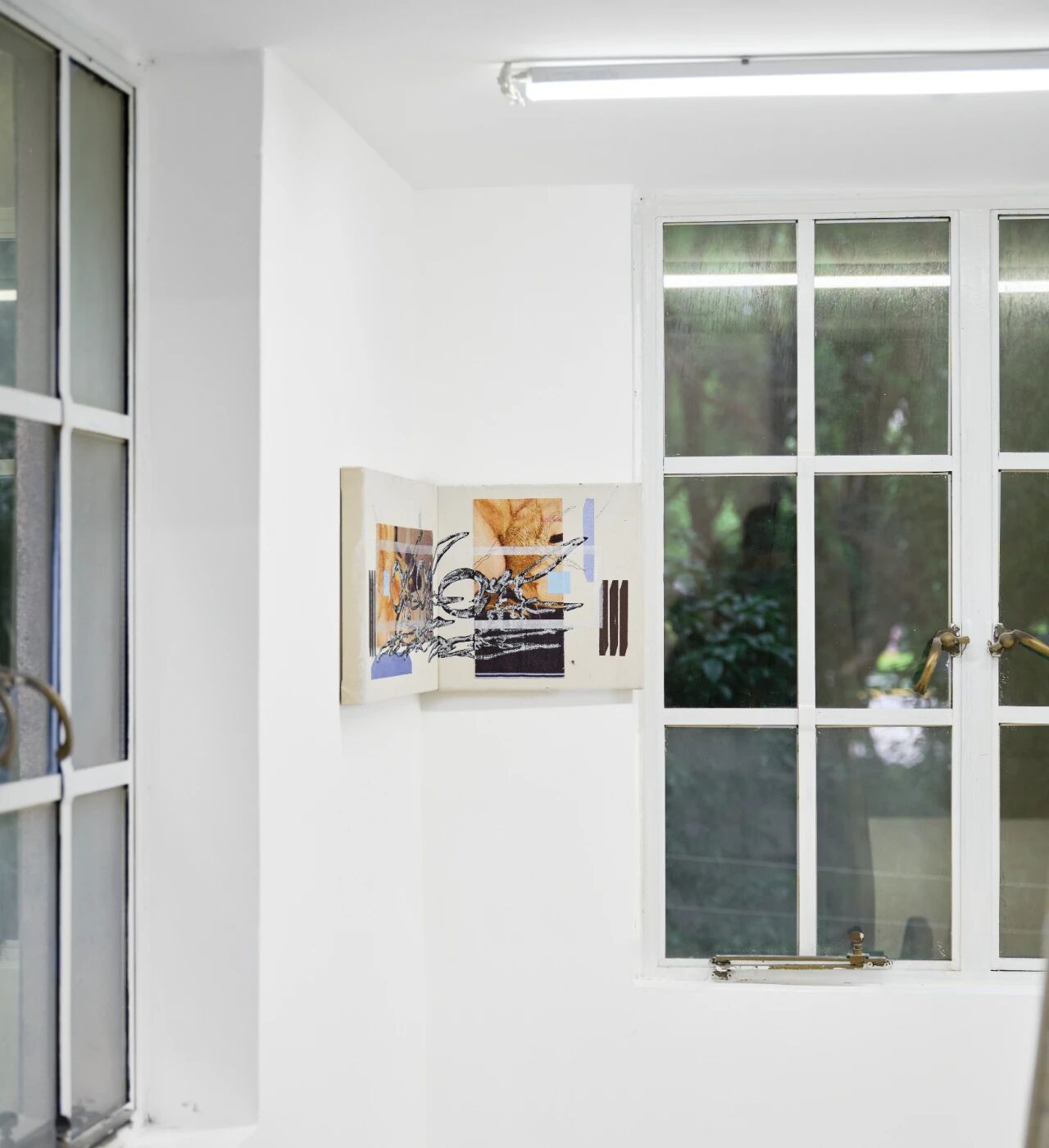

At the corner of the entrance to On Set, a blurred photographic print on fabric, stitched with cotton thread to a spliced frame, is overlaid with hand-carved stencil transfers. Artist Joyce Chonghui Wu’s work Proof Bag: Manis Blue is embedded seamlessly into the stratified layers of the space, forming the exhibition’s prologue.

Joyce Chonghui Wu
Proof Bag- Manis Blue, 2025
Printed fabric, acrylic & pastel on canvas, metal brackets
30h x 80w cm
© Courtesy of the artist
Born in Shanghai in 1994, Wu graduated from Parsons School of Design. Her background in fashion design has given her a deep familiarity and intimacy with textiles, photography, and graphic structures, elements that she continually weaves into her practice in shifting forms. In early 2025, she collaborated with the design brand pet-tree-kor to present her solo exhibition Adventitious Shoot, along with a series of joint designs. In recent years, her work has also been widely exhibited internationally, including at Green and Stone Gallery in London, Qi Mu Space in Beijing, Tank Shanghai Art Museum, and abC Art Book Fair, among other galleries, art museums, and cross-disciplinary platforms.
Beneath the dense fabric collages, the logic of queer art emerges as a central thread running throughout Wu’s practice. As Jack Halberstam argues in The Queer Art of Failure, the notion of low theory “tries to locate all the in-between spaces that high theory overlooks or dismisses.” Wu extracts and sutures elements from popular culture, street art, and marginalized visualities, reassembling them like words into statements of memory, identity, and circumstance. Guided and joined by ubiquitous stitching, these fragments form everyday archives that are at once singular and collectively resonant.

Joyce Chonghui Wu
Proof Bag- Myside’s, 2025
Canvas, printed cotton fabric, oil pastels, acrylics, cotton thread
15h x 45w cm
© Courtesy of the artist
In resonance with Tim Ingold’s concept of “wayfaring,” the act of stitching here may also be understood as a mode of being—distinct from fixed points that represent occupation and absolute power, wayfaring emphasizes the act itself, echoing the fluidity of identity across boundaries of gender, geography, and culture. What is sewn together is also the “world” itself, a fragmented archive composed through the intertwining of lines, reflecting the collective memory of queer life in circulation across regions as well as the immediacy of the present moment preserved in fragments.
The opening work Proof Bag: Man is Blue becomes the “leaflet rack” at the entrance to the Screening Room. The precision of industrial design language and the emotional flux of everyday imagery run like parallel tracks, merging into one another, attuned to the dual qualities of On Set—the extreme industrial atmosphere and the disorderly traces of the human. Geometric patterns transferred through stencils are arranged with strict spacing, linking planar layouts with three-dimensional structures. Another work, Proof Bag: Myside’s, is positioned at the exhibition’s close, tying together the narrative frame of the set through a gesture of beginning and ending. This triptych of small-scale pieces carries a sequence of rotating images, with key frames turned and tested in post-production, foregrounding the value of the negative.



Installation view of On Set, August 2, 2025 - Sept 14, 2025, Nan Ke Gallery, Shanghai ©Courtesy of Nan Ke Gallery.
The “negative” functions here as a form of the archive of the low, holding the tension of fragmentation and draft-like quality while also recording a persistent attentiveness to the everyday. The mode of assembling knowledge here departs from conventional models, but it aligns closely with the very interior of queer identity—wandering, dispersive, forming its own system from the textures and grain of the human. As Halberstam notes in The Queer Art of Failure, “under certain circumstances failing, losing, forgetting, unmaking, undoing, unbecoming, not knowing may in fact offer more creative, more cooperative, more surprising ways of being in the world.” Within Wu’s works, the notion of failure in conventional narratives is transformed into a productive stance: one that resists assimilation, embraces unpredictability, and opens the way for new possibilities to arise.
In Wu’s practice, material, structure, and image become raw matter for suturing identity, memory, and circumstance. The series not only manifests the materiality and formal logics of collage, but also articulates a queer epistemology: the world is not a stable, predetermined framework, but rather a shifting interplay of flowing lines and archival fragments. Her works thus stand as a testimony to identity, locality, and cultural circulation—opening new sensory orders within states of instability and drift.
August 21, 2025


